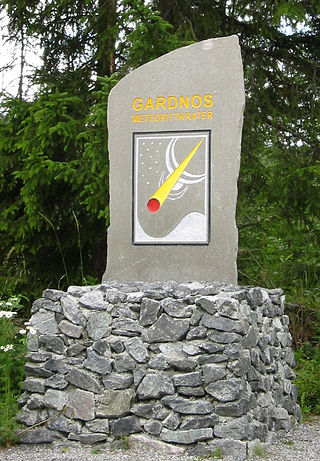
Gardnos crater is a meteorite impact crater in Nesbyen municipality in Viken county, Norway. It is located inside Meteorite Park (Meteorittparken) at Gardnos 10 km north of the town of Nesbyen.

Liverpool is a meteorite impact crater situated in Arnhem Land within the Northern Territory, Australia. It was named after the nearby Liverpool River. Liverpool is remote and difficult to access. The crater has a raised, near-circular rim averaging about 1.6 km in diameter. It was first noticed by geologists during reconnaissance geological mapping in the 1960s, and although an impact origin was considered possible, this was not confirmed until a more detailed study was undertaken in 1970.

Mistastin crater is a meteorite crater in Labrador, Canada which contains the roughly circular Mistastin Lake. The lake is approximately 16 km (9.9 mi) in diameter, while the estimated diameter of the original crater is 28 km (17 mi). The age of the crater is calculated to be 36.6 ± 2 million years (Eocene).

Suvasvesi is a lake in Eastern Finland near the town of Kuopio. Suvasvesi consists of two circular open lakes, Kuukkarinselkä in north and Haapaselkä in south. The lakes are separated by a group of islands. The lake has 688 islands in total. The area of the lake is 234 square kilometres (90 sq mi) making it the 18th largest lake in Finland. Kuukkarinselkä is the third deepest lake in Finland measuring 89.0 metres (292.0 ft) in the deepest point.

The Manson crater is an impact crater near the site of Manson, Iowa where an asteroid or comet nucleus struck the Earth during the Cretaceous Period, approximately 74 Ma. It was one of the largest known impact events to have happened in North America. Previously it was thought to have led to the extinction of the dinosaurs until isotopic ages proved that it was too old.

Kebira Crater is the name given to a circular topographic feature that was identified in 2007 by Farouk El-Baz and Eman Ghoneim using satellite imagery, Radarsat-1, and Shuttle Radar Topography Mission (SRTM) data in the Sahara desert. This feature straddles the border between Egypt and Libya. The name of this feature is derived from the Arabic word for "large", and also from its location near the Gilf Kebir region in southwest Egypt. Based solely on their interpretations of the remote sensing data, they argue that this feature is an exceptionally large, double-ringed, extraterrestrial impact crater. They suggest that the crater's original appearance has been obscured by wind and water erosion over time. Finally, they speculated that this feature might be the source of the yellow-green silica glass fragments, known as "Libyan desert glass", that can be found across part of Egypt's Libyan Desert. They neither conducted any fieldwork at this feature nor studied any samples collected from it. However, the Kebira Crater is currently not listed in the Earth Impact Database. Field trips to investigate the feature have found no supporting evidence. The "central uplift" clearly retains the horizontal bedding of the surrounding sandstone tableland, providing clear evidence against a possible impact origin.

An impact structure is a generally circular or craterlike geologic structure of deformed bedrock or sediment produced by impact on a planetary surface, whatever the stage of erosion of the structure. In contrast, an impact crater is the surface expression of an impact structure. In many cases, on Earth, the impact crater has been destroyed by erosion, leaving only the deformed rock or sediment of the impact structure behind. This is the fate of almost all old impact craters on Earth, unlike the ancient pristine craters preserved on the Moon and other geologically inactive rocky bodies with old surfaces in the Solar System. Impact structure is synonymous with the less commonly used term astrobleme meaning "star wound".

Omeonga is a town in the Sankuru province of the Democratic Republic of the Congo. It lies around 25 miles (40 km) south southeast of the nearest large town, Katako-Kombe. The Lomami river also passes nearby.

Ramgarh crater, also known as Ramgarh structure, Ramgarh Dome and Ramgarh astrobleme, is a meteor impact crater of 3.5 kilometres (2.2 mi) diameter in Kota plateau of Vindhya range located adjacent to Ramgarh village in Mangrol tehsil of Baran district in Rajasthan state of India. When formally accepted as the third crater in India, its diameter size would be between the two already confirmed craters in India - Dhala in Madhya Pradesh with 14 km diameter and Lonar in Buldhana district of Maharashtra with 1.8 km diameter.
The Impact Field Studies Group (IFSG) was a scientific organization emphasizing geologic field research of suspected and confirmed sites of impact craters and impact structures. The group is composed of researchers, professionals and students involved in study of impact sites. IFSG's web site is hosted by the Department of Earth and Planetary Sciences at University of Tennessee, Knoxville.

Traces of Catastrophe: A Handbook of Shock-Metamorphic Effects in Terrestrial Meteorite Impact Structures is a book written by Bevan M. French of the Smithsonian Institution. It is a comprehensive technical reference on the science of impact craters. It was published in 1998 by the Lunar and Planetary Institute (LPI), which is part of the Universities Space Research Association (USRA). It was originally available in hard copy from LPI, but is now only available as a portable document format (PDF) e-book free download.












